Research Results and
Recommendations for Download
Hiroshima before the atomic bombing as a military capital
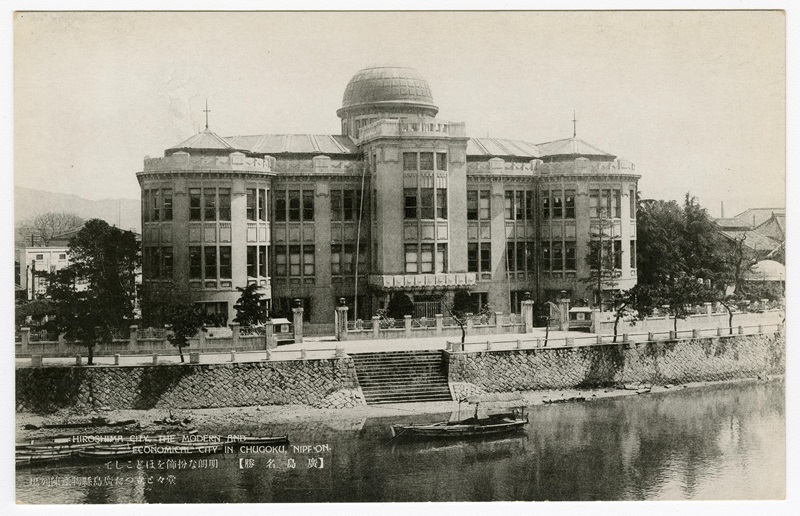 The Industrial Promotion Hall (today's Atomic Bomb Dome)
The Industrial Promotion Hall (today's Atomic Bomb Dome)
Photo: Collection and Courtesy of the Hiroshima Municipal Archives
1589: Terumoto Mori constructed the Hiroshima castle located on the delta of the Ota River.
The history of Hiroshima City begins. During the Edo period, Hiroshima was among the several large local castle towns after Nagoya, Kanazawa, and other major towns. After the Meiji Restoration, Hiroshima housed the Hiroshima Prefectural Government and the Hiroshima Garrison (later the Fifth Division) Headquarters of the Imperial Japanese Army. This enabled the city to maintain its position as the regional center of politics and military.
1888: The Fifth Division was established in Hiroshima.
1889: Ujina Port was completed.
In addition to opening the port, the City of Hiroshima underwent infrastructure development, building railroad and road networks such as the Sanyo Railroad and streetcar that traversed the delta. The city emerged as a home to the large-scale factories of the heavy and chemical industries between World War I and World War II. The heavy and chemical industries developed as Hiroshima's major industries.
1894: The First Sino-Japanese war broke out.
The outbreak of the First Sino-Japanese War in July 1894 created Hiroshima as a major base for troop dispatch and military logistics.
1902: The state-run Hiroshima Higher Normal School opened.
The school is known as the leading institution in the field of education in western Japan along with the Tokyo Higher Normal School. Moreover, many national government offices and branch offices of nationwide business were established in the city.
Hiroshima's history as a center of administration, military operations, and educational pursuits led to its transformation into a modern city.
1929: A poison gas production facility on Okunoshima Island was constructed.
Although not on maps of the time as a military secret and generally unknown to the public, the production of poison gas was conducted on Okunoshima Island in the Seto Inland Sea. Moreover, during the final days of World War II, the Second General Army headquarters, established to command troops in western Japan, were stationed in Hiroshima in preparation for a decisive battle on the mainland, further enhancing the city’s importance as a military city.
The atomic bomb was dropped on Hiroshima.
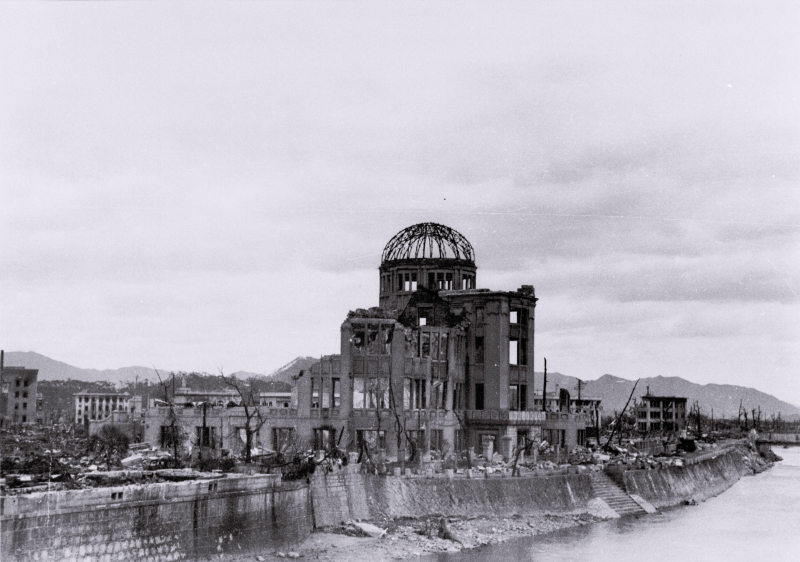 The Industrial Promotion Hall after the bomb was dropped (today's Atomic Bomb Dome)
The Industrial Promotion Hall after the bomb was dropped (today's Atomic Bomb Dome)
Photo: Toshio Kawamoto Courtesy of Yoshio Kawamoto
August 2, 1945: Order to Drop an Atomic Bomb on Hiroshima
On July 25, the United States narrowed down the potential targets of the A-bombing to the four cities of Hiroshima, Kokura, Niigata, and Nagasaki (Kyoto was originally included but excluded for political reasons). On August 2, the decision to use an atomic bomb on August 6 was made, with Hiroshima as the first target.
August 6, 1945–8:15 am:
The Enola Gay, a B-29 bomber, departed from Tinian Island in the Mariana Islands and headed straight to Hiroshima with an atomic bomb “Little Boy.”
On August 6 in the morning, the weather in Hiroshima was sunny, but at 8:15 am., the serenity was shattered when the Enola Gay dropped an atomic bomb. After falling for approximately 43 s, it exploded mid-air in a nuclear eruption nearly 600 m above the Shima Hospital, slightly southeast of the Aioi Bridge, which was the target. Upon explosion, a gigantic fireball appeared, emitting intense heat rays that caused the ground temperatures of the surrounding area to reach from 3,000°C to 4,000°C. Also, the intensive bomb impact created maximum wind speeds of 440 m/s at the hypocenter. The blast spread out rapidly and swept the entire city in about 10 s.
Although the heat rays were only emitted for a short span of time, their extreme intensity caused anyone within a 1-km radius from the hypocenter either to die on the spot or to receive multiple severe burns. Even people over 3 km away from the hypocenter suffered severe burns on the exposed parts of their bodies. Wooden structures located within 2 km of the hypocenter were completely destroyed, and there were people trapped under the remains.
Shortly after, the fires broke out spontaneously from the heat rays, and the initial blazes that started among ruined buildings spread rapidly. Thirty minutes after the explosion, Hiroshima was covered in a disastrous firestorm. Everything within a 2-km radius of the hypocenter was engulfed in flames, and many people were burned to death.
Radioactive waves emitted from the explosion caused severe damage to the human body. At a distance of 1 km from the hypocenter, neutrons and gamma rays gave off four grays of radiation, sufficient to cause the death of one out of every two people. One after another, people with no external injuries became sick after a couple of days and later died. People who were not directly exposed to the atomic bombing were also exposed to radiation. This included those who lived on the outskirts of town, where people were not directly exposed to the bombing but were exposed to the radioactive black rain that fell, and those who were exposed to residual radiation upon entering the city.
On August 6, the day of the atomic bombing, the population of Hiroshima is estimated to be about 350,000 people, including inhabitants, military personnel, and people who lived outside the city and commuted to the city for work. At that time, there were not only Japanese people but also numerous people of different nationalities living in the city. They included Japanese-Americans born in the United States, exchange students from Southeast Asian countries, people from the Korean Peninsula and Taiwan, which had both been under Japanese colonial rules at that time, and people from the Chinese mainland. None of them escaped the devastation of the atomic bombing. While the exact number of dead people from the atomic bombing is unknown, it is estimated that the number of deaths was approximately 140,000±10,000 at the end of 1945.
|
The Dropping of the Atomic Bomb |
August 6, 1945–8:15 am. |
|---|---|
|
Destruction wrought by the A-bomb |
|
|
Death (by the end of December 1945) |
Around 140,000±10,000 had died. The figure for Nagasaki was around 74,000±10,000. |
|
Current status of A-bomb survivors |
Total population in Japan: 106,825 (Hiroshima City: 37,818) Average age: 85.58 (Hiroshima City: 85.20) |
Source: “Hiroshima Pocket Peace Guide” (Produced by Peace Promotion Division, International Peace Promotion Department, Citizens Affairs Bureau, The City of Hiroshima)
Hiroshima's reconstruction
Reconstruction just after the atomic bombing
The atomic bombing completely destroyed the city, including buildings and public infrastructure, such as transportation and communication facilities and water and sewage systems. The reconstruction of Hiroshima City first began with the development of urban infrastructure under the national government's war-damage reconstruction project, which targeted 115 war-damaged cities in Japan.
- August 8, 1945 (two days after the bombing):
The Japanese National Railways Sanyo Line was reopened between Hiroshima and Yokogawa (a station next to Hiroshima Stations). - August 9, 1945 (three days after the bombing):
Streetcar operations partially resumed in one section. - August 10, 1945 (four days after the bombing):
The electric water pump at the Ushita Water Supply Station resumed operations. (Backup pumps had started supplying water around 2:00 p.m. on August 6.)
(However, water leaked and spouted at many places in the city. Repairing the waterworks was an arduous task. Notably, it took nine months to restore the water supply to the outskirts of the city.)
Reconstruction Planning
Regarding the city's reconstruction plan, the Hiroshima City Reconstruction Council and newspapers published 34 reconstruction plans proposed by citizens, government officials, and foreign people. It was thought that reconstruction of the city from the ruins would be nearly impossible; however, the reconstruction plan pursued the highest ideals attainable at the time, with ambitious plans for roads, including 100-m wide roads, parks, green areas, and land readjustments to secure land for infrastructure. At that time, Hiroshima City had financial difficulties with its budget. Citizens and those who were engaged in the reconstruction had to work hard. Sometimes, heavy burdens were imposed on citizens for the sake of reconstruction. At the same time, various forms of aid and support from overseas helped Hiroshima citizens to overcome the crisis that followed in the aftermath of the bombing.
The Hiroshima Peace Memorial City Construction Law
1949: The Hiroshima Peace Memorial City Construction Law was enacted.
Initially, the Hiroshima Reconstruction City Planning encountered many problems such as financial difficulties, lack of human resources, and shortages in materials and public land. Because of the catastrophic damage from the bombing, tax revenue was minuscule in Hiroshima City. To cope with these conditions, Hiroshima mayor Shinzo Hamai, city council members, and other local people concerned made strenuous efforts to find a way and lobbied the national government and the Diet. As a result of their efforts, the Hiroshima Peace Memorial City Construction Law was enacted as a special law and was supported by the local referendum and promulgated and enforced on August 6, 1949.
The enactment of this special law paved the way for special assistance from the national government, facilitated the transfer of national government properties, and pushed reconstruction efforts forward. Moreover, Hiroshima City was designated as a “peace memorial city” under Article 1 of the law stating, “Hiroshima is to be a peace memorial city symbolizing the human ideal of the sincere pursuit of genuine and lasting peace.” This designation became a vital part of the city’s new identity of “peace.”
1952: “Hiroshima Reconstruction City Plan” was amended to the “Hiroshima Peace Memorial City Construction Plan.”
A special project for constructing “peace memorial facilities” was approved, and this made the construction of the Peace Memorial Park, one of the special features of the reconstruction plan, possible.
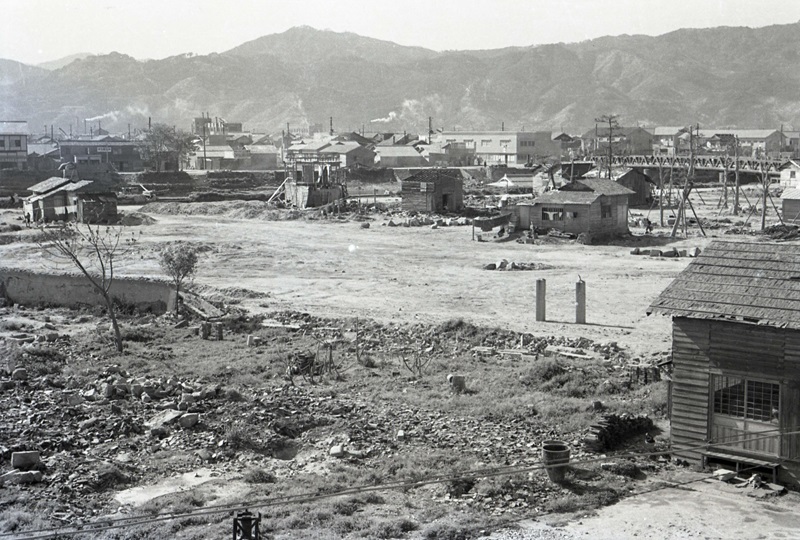 Peace Memorial Park Under Construction (1952)
Peace Memorial Park Under Construction (1952)
Photo: Collection and Courtesy of the Hiroshima Municipal Archives
1955: The display hall (today’s main building of the Hiroshima Peace Memorial Museum) and the Peace Memorial Hall (today's Peace Memorial Museum's East Building) were completed.
The construction took a long time because of the tight budget, and the buildings were left unfinished for some time. Four years after the start of construction work, the buildings were completed.
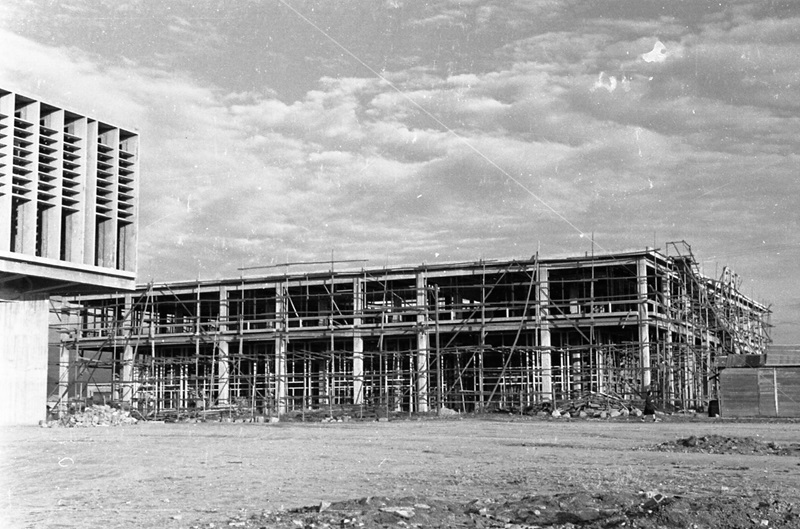 Peace Memorial Park Near Completion (1954)
Peace Memorial Park Near Completion (1954)
Photo: Collection and Courtesy of the Hiroshima Municipal Archives
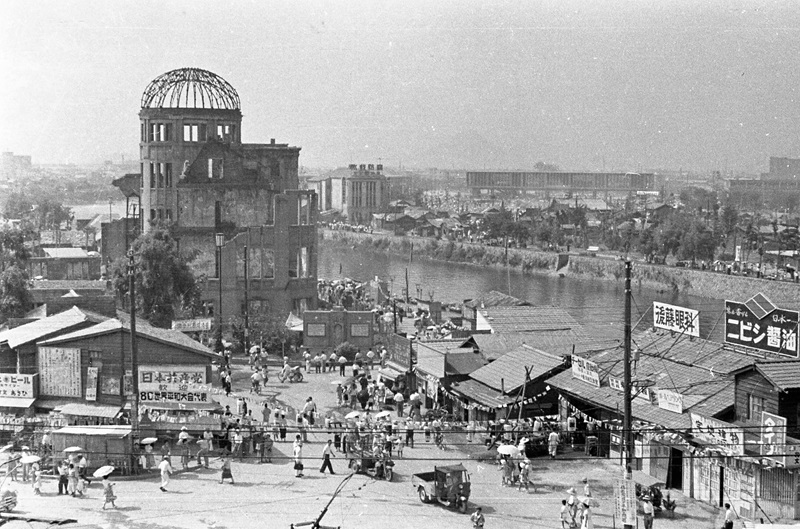 Scene around the Atomic Bomb Dome (1955)
Scene around the Atomic Bomb Dome (1955)
Photo: Collection and Courtesy of the Hiroshima Municipal Archives
The benefits of the Hiroshima Peace Memorial City Construction Law were extensive and not limited to just such special financial assistance from the national government. The law also provided moral support to the citizens by assuring them that the national government was watching over and assisting them.
Conversely, the reconstruction process in Japan typically started with a public authority that established the infrastructure. Once the land was prepared, the private sector, encompassing land owners, building owners, and residents, took charge in determining the types of buildings to be constructed and how to rebuild livelihoods. However, many people struggled daily just to get by, and it was quite difficult to build their houses on their own.
The implementation of the Peace Memorial City Construction Plan faced criticism and dissatisfaction from the citizens from time to time, such as disapproval for the land readjustment policies. It is important to remember the burden and sacrifices made by the citizens during the reconstruction process.
Reference: “Hiroshima's Path to Reconstruction,” “Hiroshima for Global Peace” Plan joint Project Executive Committee (Hiroshima Prefecture and the City of Hiroshima).
Information related to this page
- Hiroshima's Path to Reconstruction
- Learning from the testimonies of A-bomb survivors (Jump to external site) NHK Memories of the A-bomb: Hiroshima and Nagasaki

